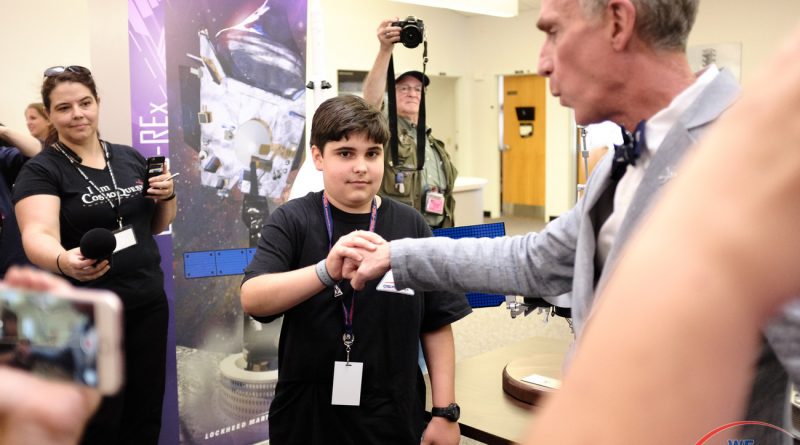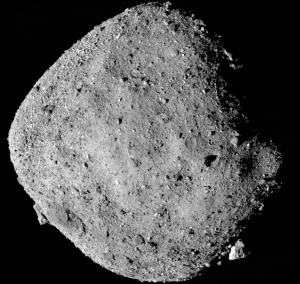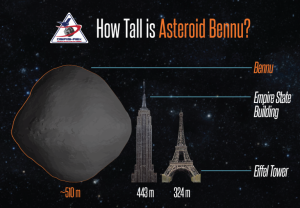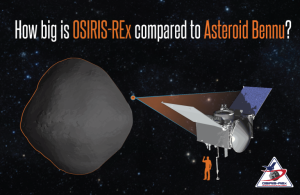OSIRIS-REx Set For Bennu Orbital Insertion Today

At 2:43:55 PM EST today, the OSIRIS-REx spacecraft will begin orbiting asteroid Bennu. This will make Bennu, which is only about 1,600 feet across, the smallest object ever orbited by a spacecraft. Launched on September 8, 2016, the OSIRIS-REx spacecraft arrived in the vicinity of Bennu on December 3, 2018.

During December, the spacecraft completed flyovers of Bennu’s north pole, equatorial region, and south pole, getting as close as nearly 4 miles above Bennu during each flyover. The mission’s navigation used the preliminary survey to calculate Bennu's mass and spin rate. This information is used to to plan the orbital operations around Bennu.

Credit: University of Arizona

Credit: University of Arizona
Based in Simi Valley California, the Space Navigation and Flight Dynamics (SNAFD) practice of KinetX, Inc. provides mission design and navigation services for a variety of deep space missions. In a Tweet this morning, they confirmed: Orbit insertion burn design has been finalized: OSIRIS REx will fire its thrusters to enter orbit about Bennu at 14:43:55 EST on December 31, 2018. The engines will burn for 8 seconds.
Orbit insertion burn design has been finalized: @OSIRISREx will fire its thrusters to enter orbit about Bennu at 19:43:55 UTC (14:43:55 EST) tomorrow, December 31st! The engines will burn for 8 seconds. pic.twitter.com/gSI24og2Ix
— KinetX SNAFD (@KinetXSNAFD) December 31, 2018
During Orbital Phase A, OSIRIS-REx will come close to approximately three quarters of a mile to its surface. In February 2019, several instruments work together to map Bennu and determine its global spectral, thermal, and geological properties of Bennu to determine the best site for sample collection. During Orbital B, OSIRIS-REx continues to map Bennu at higher resolutions, with a focus on candidate sample sites. At the end of Orbital B, a sample site will be selected.
In July 2020, the OSIRIS-REx spacecraft will approach Bennu and use a sample collection arm to collect a sample of the asteroid. The robotic arm will release a burst of nitrogen gas designed to blow small particles from the asteroid into the sample collection head. After five seconds of collection, OSIRIS-REx will back away from Bennu and measure the amount collected. The mission plan allows for up to three attempts to collect anywhere from 2.1 ounces to 4 pounds of material from the asteroid. At the pre-launch press event in Titusville, I asked Principal Investigator Dante Lauretta if the team would try a second attempt if the first collection retrieves only 2.1 ounces of material. Lauretta explained, "As soon as we get 60 grams of material, we have met the mission objectives and will not risk another approach to get more material. 60 Grams of regolith will be enough material to fuel scientific exploration for decades."
Upon successful collection of particles from Bennu, OSIRIS-REx will begin a two-year journey back to Earth. Four hours before Earth arrival on September 24, 2023, OSIRIS-REx will jettison a Sample Return Capsule for landing in the Utah desert. The OSIRIS-REx spacecraft will perform a final deflection maneuver to a stable orbit around the Sun. On Earth, the sample material will be analyzed down to the atomic level to determine the asteroid's chemical composition. Sample scientists will look for organic compounds like amino acids and sugars, the building blocks for life.

Stunning, full color photo book covering every east coast launch spanning 2014-2015, including the first-ever powered landing of a SpaceX Falcon 9 rocket.
More Info



